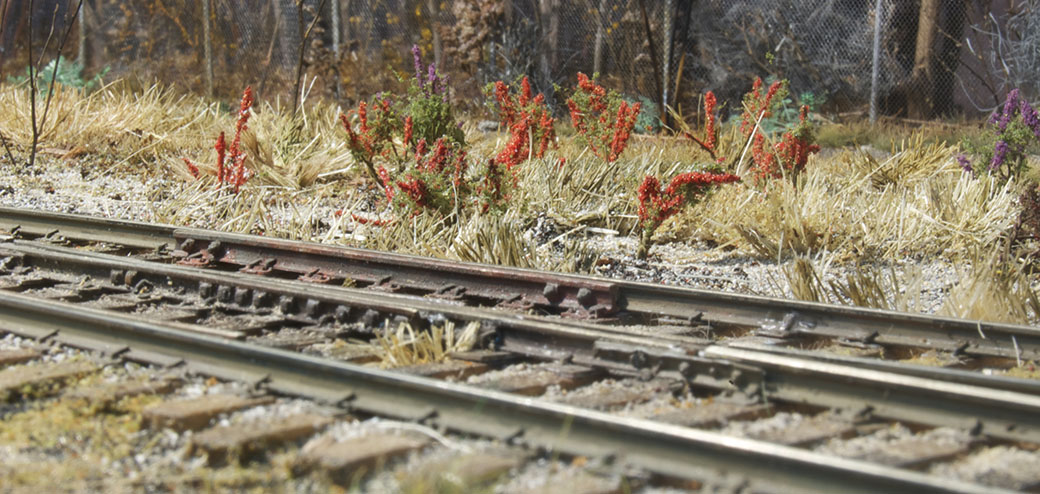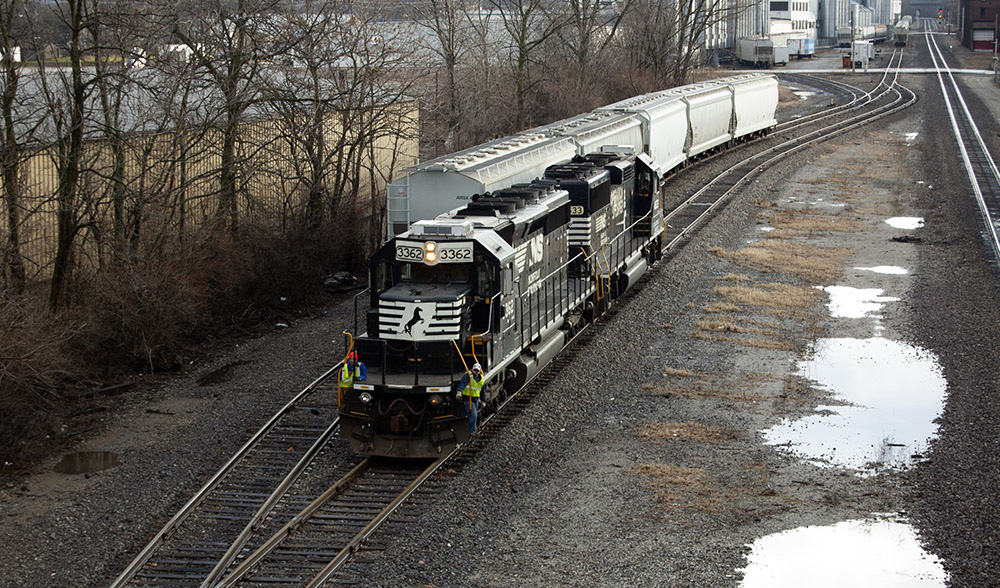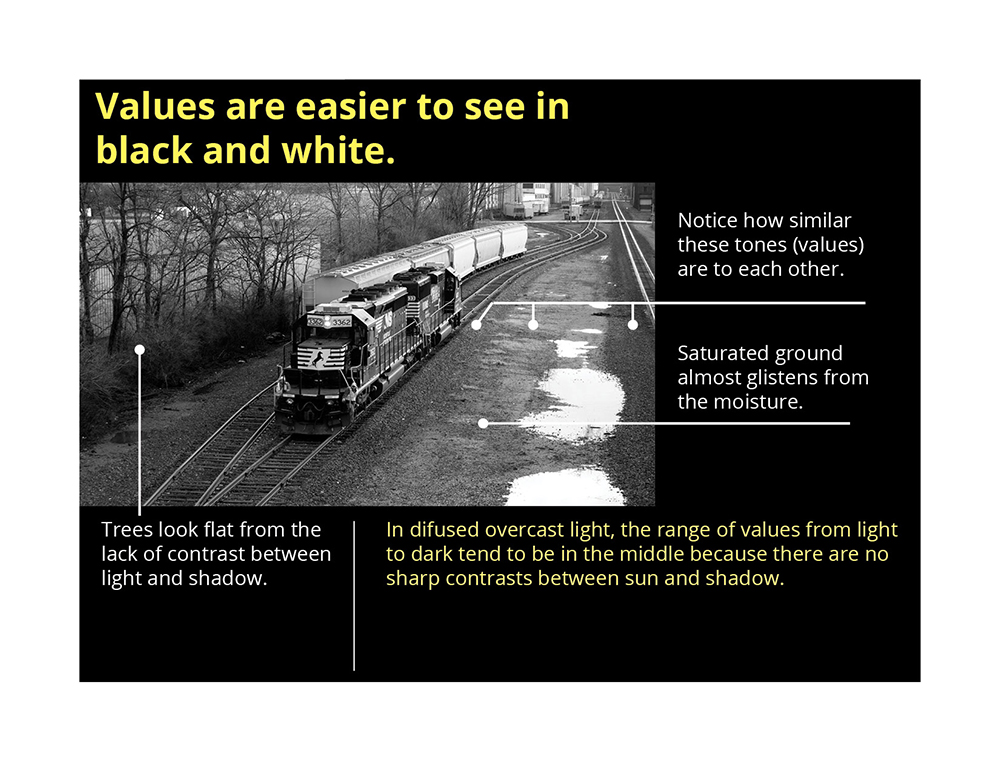
Interpreting The Landscape
A question came up in the comments last week about modeling the dark wet gloom of the Pacific Northwest. I’ve never been to the northwest, so I really can’t offer anything intelligent about modeling that specific region. What I can do with this post is offer an interpretation of wet and dreary conditions closer to home. I believe there are broad principles that apply to many parts of the country.
Let’s take a look and break down a couple of photos.

This scene of L84 at work gives us clues about recent weather conditions. You’ll see a number of large rain puddles near the main and on the far left along the access path near the tree line. In wet conditions, any low spot may fill with water or at least have a darker color from the dampness.
An important thing to understand is how the values (the light and dark aspects of a color) will look under such conditions. To help explain this, I converted the photo to black and white.

Note how dark the ballast color is throughout the image and also how similar in value it is to the surrounding ground. Notice also how the more saturated portions of ground between the tracks seem to glisten with moisture. To capture this on a model, you might try adding thin applications of gloss medium or water based gloss polyurethane. I would makeup a small test piece with ground cover or ballast and experiment until I got the results I wanted before trying it on the layout.
Another thing to notice with the values is how close they are throughout the scene. Under this kind of light, such a narrow range of values makes things look one-dimensional.
Looking at the tree line on the left, you’ll notice how featureless it appears. The trees and scrub brush read as a similar mass of dull color. There is texture in the branches and undergrowth but little in the way of contrast between highlights and shadows that give individual trees their shape and clarity. The brightest highlights are the reflections on the railheads and the glow of the headlight. Even the light gray hopper cars and white markings on the locos are several shades darker than their pure tones. Lastly, with all the values in such a tight range, a spot of strong color goes a long way. The strongest colors in the first image are the crew’s yellow safety vests and the guy’s hunter orange hat. Both of these really stand out against all the drab tones around them.

This shot of the depot gives us another perspective on rainy effects. The streets are clearly wet and reflect the building colors. Once again note how uniform in color the wet surfaces are. I’m not certain how I would model this effect. A gloss coating of some kind is the obvious choice and A-K Interactive has a wash for wet effects but I’ve never used it, so I can’t speak to its effectiveness. Effects like this need to be handled with care, as things can get out of hand quickly.
At least one modeler that I know of is modeling a rainy landscape. Jim Smith-Wright of the UK has a fine exhibition layout called Brettell Road that depicts an industrial area with a dreary atmosphere. To say this type of atmospheric setting is a challenge is an understatement, but Jim is well up to the task. I’ve included several links to his work at the end of the post and if you happen to have a copy of the Model Railway Journal No. 257, you might check out the evocative photos of his layout.
To wrap up, I encourage you to ask questions. If I don’t know the answer or where to find it, I’ll say so. Likely as not someone will know and we can all learn. Knowing what you folks struggle with or don’t understand about a post will help me improve the blog and future books by making both more relevant to your needs.
Regards,
Mike
Links to Jim Smith-Wright’s Brettell Road
A nice photo of the layout and its presentation.
Thanks for the mention Mike
Jim
Mike, if you substitute those NS engines for UP or BNSF engines in that picture you’d be darn close to what it looks like up here in the PNW.
One way I learned to approach seeing values is to squint. This takes out all the noise of the many variants of value and compresses things down to just a few of the darkest/lightest values so you can see the contrast and how value affects what you’re seeing.
Brettell Road is a lovely layout. Do you think that going to the extreme of rain is too much? I wonder if it’s like the best snow layouts, the snow dominates the experience, which is great, but the trains become secondary players, making the layout more of a weather model than a rail model? Like keeping backdrops simple, I wonder if it’s better to not cover everything in wet effect. While things here in Seattle are wet when it is raining, much runs off and things do lose the gloss, except the hardest surfaces and vehicles. What do you think of a post-rain dark gray sky with puddles instead of an overall wetness? For dirt and other surfaces, I’d think about darker hues for the colors used to make them look wet?
Jim,
You’re welcome. It’s brilliant work as always.
Dave,
I agree with your assessment. I’ve modeled remnants of snow cover in the past and tired of it quickly. But the bare winter landscape here holds my interest completely. A theory I have is that unless you’re modeling snow country, such conditions are transitory in nature. Here in my part of Indiana, we get snow to be certain, but a long snow cover is becoming less common than it used to be. The trees are bare now and the grasses are starting to turn their dull winter color, both will last until the growing season starts again next spring. I think it’s the duration that lets it work in model form. Summer greenery is the other common example. The season is long enough that we get used to it, while we know that Spring and Fall colors only stay for a few short weeks.
It goes back to the idea of modeling the commonplace and the ordinary. Having said that, I think the after effect of a rain shower could be quite compelling.
Mike
Following this conversation is interesting. As one of the few crazy people that try to model outdoors, I don’t have to recreate the weather. I just join along. That said most people probably aren’t interested in ops in the rain, but I’ve done plenty of those at a much larger outdoor layout here in Seattle.
Here’s some food for thought for those modeling a wet season. Remember all flat surfaces collect rainwater. That means railcars too. Often switchman in the Seattle area will wear rain coats the day after it rains. After the first time a car hits a standing car after a rainstorm and you get rainwater all over you learn real fast.
I would think that if you applied a glossy/wet look to all the car tops/sides it would overdo the look, but maybe 1 or 2 cars it might look okay.
Craig
Interestingly Brettell Road was used as an experiment for exactly what Dave describes. I had ideas of doing New Street after the rain where the surfaces had dried but there were still puddles. Think about an hour after a rain shower on a reasonable day. I didn’t want to just dive in on that layout hence the idea of going full wet on this layout.
I very much consider the trains secondary players these days. Initially I didn’t but now I approach models as a scene that has trains in it rather than trains with a background.
It’s interesting that you say that about the trains being secondary characters Jim. I’ve also been moving toward a similar view.
Craig, I never get tired of the insights only a professional would know.
Mike
Thank you Mike,
I’m following along and your doing a great job explaining things
You’re welcome Patrick and thanks.
Mike